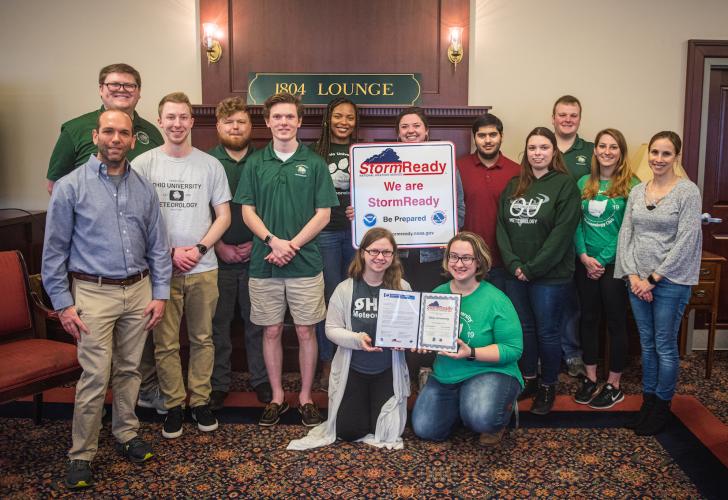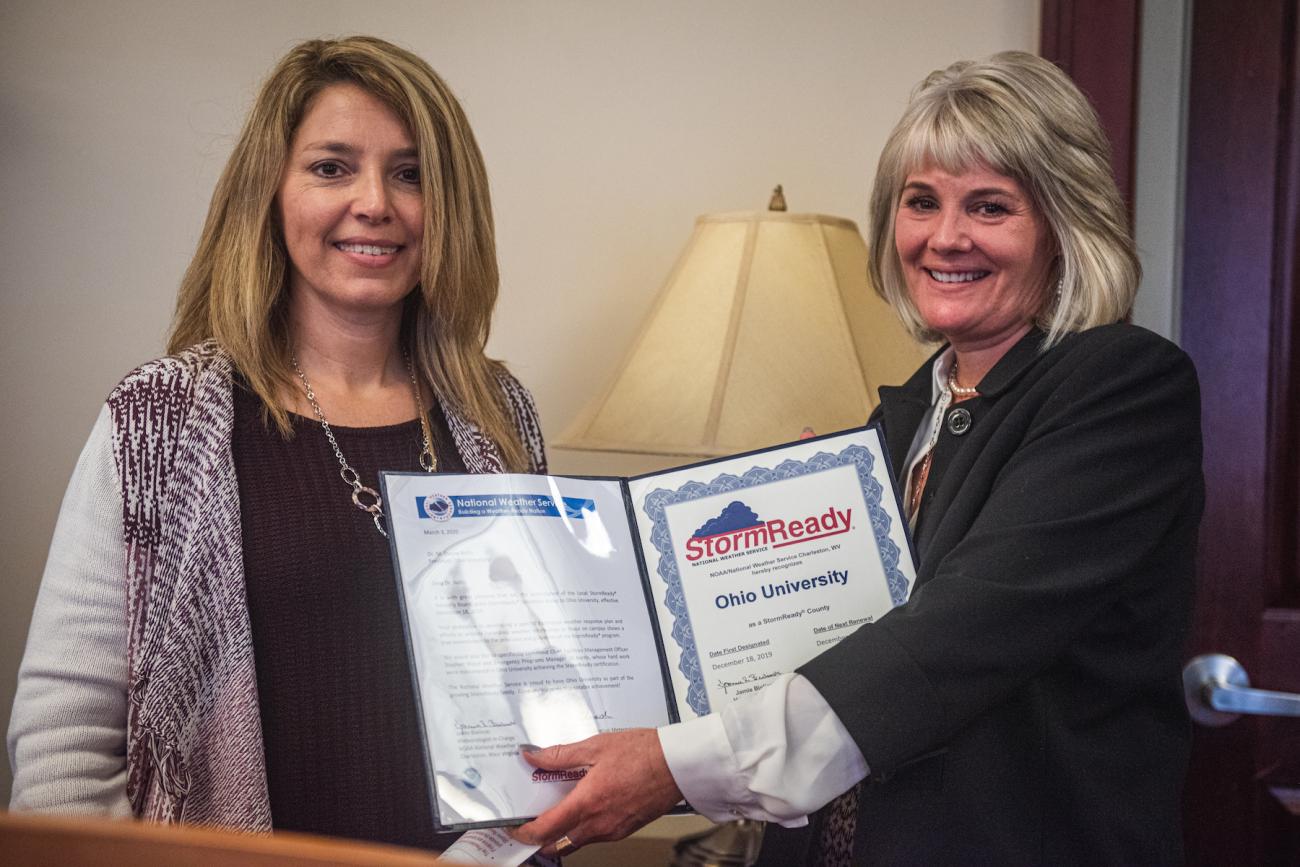
OHIO is StormReady for extreme weather events

The National Weather Service recertified Ohio University as StormReady and commended the University for its efforts in a ceremony held in the Baker University Center’s 1804 Lounge on Tuesday, March 3.
“I am so proud that Ohio University was recently awarded the StormReady designation by the National Weather Service,” said President M. Duane Nellis. “Thanks to the work of the exemplary students, faculty and staff who have worked hard to achieve this designation, I am confident that our campus will be well prepared in the event of severe weather in our region.”
StormReady is a National Weather Service program that aims to help prepare people for extreme weather events. In order to be a StormReady site, a community must establish a 24-hour warning point and emergency operations center, have more than one way to receive severe weather warnings and forecasts and to alert the public, create a system that monitors weather conditions locally, promote the importance of public readiness through community seminars, and develop a formal hazardous weather plan.
“The StormReady program helps our communities with the communication skills needed to save lives and property before, during and after the event,” said Steve Wood, chief facilities management officer, while opening the ceremony.
Jamie Bielinski, meteorologist-in-charge at the National Weather Service in Charleston, W.Va., boasted about the University’s efforts.
“I am just so excited at the extent of instrumentation and the warning methods and the work that goes in to keep this campus and student body safe,” Bielinski said. “I am very impressed.”
There are 12 universities in Ohio with the StormReady recognition, and Bielinski expressed that she hopes other universities and students will follow in OHIO’s footsteps to get prepared. “You should be proud of yourself for the hard work and continue to strive to do this type of work,” she said.

Bielinski presented the StormReady recognition award to Deb Shaffer, OHIO senior vice president for finance and administration.
“We have more than 30,000 students along with thousands of faculty and staff. We have to be prepared for any weather conditions that arise on our campus to keep our faculty, students, staff and visitors safe,” Shaffer said.
OHIO’s StormReady program is a collaboration between the Emergency Management Office, Dr. Ryan Fogt, Scalia Laboratory director, and his students, along with the Ohio University Chapter of the American Meteorological Society (OUCAMS).
“For me, it is really a great show of how much the students here care about weather safety. They worked diligently with Jill Harris, our emergency manager, and many others across campus to ensure that when inclement weather threatens our campus, we have plans in place to keep people and property safe and protected,” Fogt said.
The recertification process began in 2018, when Matt Thigpen, current meteorology student and then OUCAMS president, along with Austin Patrick, now an OHIO graduate and then OUCAMS vice president, set out on the goal of getting the StormReady recertification for OHIO. The two worked with Harris to review the plan.
Thigpen and Patrick, along with OUCAMS members, conducted site visits at all 35 weather radio locations on campus to evaluate the devices and obtain new ones if needed.
Another way meteorology students worked towards StormReady certification was by having Scalia Laboratory students on site during all home football games to monitor changing weather conditions and help in any inclement weather decision support, which Fogt noted that thankfully, there were no issues this past season.
“The students really do take the extra effort to take what they are learning in classes and use it to best benefit the community around them, part of the reason undoubtedly our student chapter was recognized at the national level this year,” Fogt said. OUCAMS received Outstanding Student Chapter of the Year in January by the American Meteorological Society.
The students also held multiple events around campus to bring extreme weather planning awareness, including their annual meteorology symposium, a Greek Life severe weather presentation, and a resident life severe weather safety talk.
“Having an informed public will help them make the right decisions when severe weather strikes in turn helping to save lives and protect property,” said Thigpen. “Our main goal is finally complete but there are still plenty of opportunities for our meteorology students to get involved within the university and community to help with forecasting and planning of events around campus and around Athens.”
